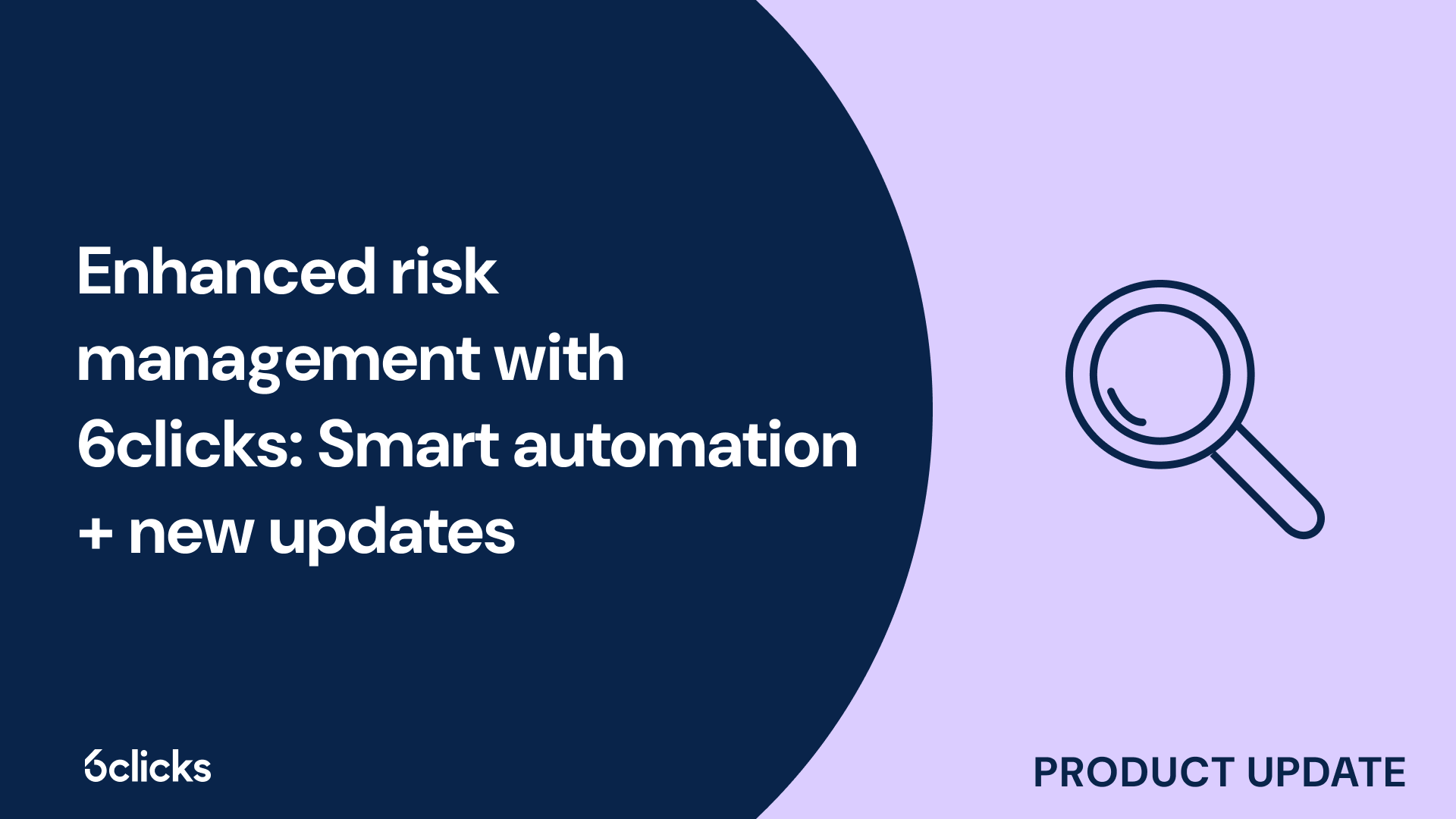Cyber Risk Management Expert Guide
Get the answer to this question "What are the six 6 types of attacks on network security?" For risk and compliance leaders from the team at 6clicks
-1.png?width=200&height=249&name=Group%20193%20(1)-1.png)
Cyber Risk Management Expert Guide
Definition of network security
Network security refers to the measures and protocols designed to protect computer networks and the data transmitted within them from unauthorized access, misuse, or damage. In an increasingly interconnected world, where businesses and individuals rely heavily on networked systems and the internet, network security is crucial to safeguard sensitive information and maintain the integrity, confidentiality, and availability of data. By implementing various security measures and technologies, such as firewalls, encryption, authentication, and intrusion detection systems, network security aims to prevent and detect unauthorized access, data breaches, and other types of cyber attacks. With the rapid advancement of technology and the evolving nature of cyber threats, network security continuously adapts and evolves to stay ahead of potential risks and vulnerabilities. Understanding the different types of attacks on network security is essential for organizations and individuals to effectively protect their network and data.
Types of network attacks
The security of computer networks is constantly threatened by various types of attacks. Understanding these attacks is crucial in order to implement effective security measures. Six common types of network attacks include code and SQL injection attacks, unauthorized access, distributed denial of service (DDoS) attacks, man-in-the-middle attacks, privilege escalation, and insider threats.
Code and SQL injection attacks involve inserting malicious code or SQL statements into vulnerable software applications. These attacks exploit vulnerabilities in the application's input validation mechanisms, potentially leading to data breaches or unauthorized access.
Unauthorized access refers to gaining entry to a network or system without permission. This can occur through various methods, such as weak passwords, unpatched vulnerabilities, or stolen credentials. Unauthorized access can result in data theft, malware distribution, or disruption of network services.
DDoS attacks target network resources by overwhelming them with a flood of traffic, rendering them unavailable to legitimate users. These attacks typically involve botnets or networks of compromised devices.
Man-in-the-middle attacks intercept and modify communication between two parties without their knowledge. This allows attackers to eavesdrop on sensitive information or tamper with data exchanged between the parties.
Privilege escalation involves an attacker gaining higher levels of access privileges than originally intended. This allows them to perform unauthorized actions or access sensitive data.
Insider threats occur when individuals with legitimate access to a network misuse their privileges for malicious purposes. This can include stealing confidential data, introducing malware, or disrupting network services.
These attacks exploit vulnerabilities in network security, potentially leading to data breaches, unauthorized access, or disruption of network services. Implementing strong security measures, such as regular software updates, strong passwords, and access controls, can help mitigate the risks associated with these types of attacks.
Malicious software (Malware)
Malicious software, commonly known as malware, is a significant threat to network security. Malware encompasses a variety of harmful software designed to infiltrate systems and networks with the intention of causing damage, gaining unauthorized access, or stealing sensitive information. There are various types of malware, including viruses, worms, Trojans, ransomware, spyware, and adware. Viruses attach themselves to legitimate files and replicate when the infected file is executed. Worms spread rapidly through networks without the need for human interaction. Trojans disguise themselves as legitimate software to trick users into downloading and installing them, granting attackers access to the system. Ransomware encrypts files, holding them hostage until a ransom is paid. Spyware monitors user activity, collect information, and potentially compromise privacy. Adware displays unwanted advertisements and can track user behavior. Employing strong passwords, antivirus software, and regularly updating software applications can help protect against these malware attacks. Additionally, exercising caution when opening email attachments or clicking on suspicious links can minimize the risks associated with malware infiltration.
Common types of malware
Common types of malware pose significant threats to network security. These malicious software variants can wreak havoc and compromise the integrity and confidentiality of sensitive data. Let's explore some of the most common types of malware:
- Ransomware: This type of malware encrypts the victim's files or locks their entire system until a ransom is paid. Recent examples of ransomware include WannaCry and Petya.
- Fileless Malware: Unlike traditional malware that resides in files, fileless malware operates directly in computer memory. It is often difficult to detect and can exploit vulnerabilities in software applications.
- Spyware: This malware silently collects sensitive information, such as keystrokes, passwords, and browsing habits. Spyware is designed to operate covertly, compromising user privacy.
- Trojans: Disguised as legitimate software, trojans deceive users into installing them. Once installed, they can perform a variety of malicious activities, such as stealing data or granting remote access to hackers.
- Worms: Worms self-replicate and spread across networks, often exploiting vulnerabilities in network protocols. They can overload network devices, slowing down or disrupting network operations.
These malicious software types highlight the various ways in which network security can be compromised. To protect against malware attacks, organizations must employ robust cybersecurity measures, including strong passwords, regular software updates, antivirus software, and user education.
Effects of malware on network security
Malware attacks pose significant threats to network security, compromising the confidentiality, integrity, and availability of data and systems. These attacks can have severe consequences, including unauthorized access, data breaches, system crashes, and financial losses.
When malware infiltrates a network, it can gain unauthorized access to sensitive information, such as credit card details or personal data, leading to data breaches and potential legal liabilities. Moreover, malware can manipulate or delete data, compromising its integrity and making it unreliable for decision-making processes.
The effects of malware on network security extend beyond data compromise. System crashes caused by malware can disrupt critical business operations, resulting in significant financial losses and reputational damage. Furthermore, malware can create backdoors or grant remote access to unauthorized individuals, allowing them to exploit the network for malicious purposes.
To mitigate the impact of malware attacks, it is crucial to implement robust security measures. This includes using strong passwords, implementing multi-factor authentication, and regularly updating and patching software applications. Deploying reliable antivirus software can help detect and remove malicious programs before they can cause significant harm.
Man-in-the-middle attack
A man-in-the-middle (MITM) attack is a type of cyber attack where an attacker secretly intercepts and alters communication between two parties without their knowledge. The attacker positions themselves in the middle of the communication flow, allowing them to view and manipulate sensitive information exchanged between the two parties. This type of attack poses a significant threat to network security as it allows attackers to eavesdrop on confidential conversations, steal valuable data, or even inject malicious code into the communication stream. MITM attacks can occur on various platforms, including email, instant messaging, internet browsing, or even mobile apps. To protect against MITM attacks, it is essential to use secure and encrypted communication channels, regularly update devices and software with the latest security patches, and implement robust authentication and encryption protocols. Increasing awareness and educating users about the risks associated with MITM attacks can also go a long way in preventing this type of cyber threat.
How does it work?
A cyber attack refers to the process where hackers gain unauthorized access to a computer or computer system. There are various methods and techniques used by these malicious actors to achieve their objectives. Here, we will discuss how cyber attacks work and the techniques used by hackers to gain access to sensitive information.
One common type of cyber attack is the use of malicious software or malware. This includes malicious code that is covertly installed on a system to gather data or take control of the computer. Another technique is the use of phishing attacks, where hackers create fraudulent emails or websites to trick users into revealing their personal information, such as credit card details or login credentials.
Man-in-the-middle attacks involve intercepting communication between two parties, allowing the attacker to eavesdrop or modify the data being transmitted. Ransomware attacks encrypts a victim's files and demands payment in exchange for the decryption key. Social engineering is another tactic, where hackers manipulate individuals into disclosing sensitive information or granting access to secure systems.
To mitigate these threats, it's crucial to implement security measures such as strong passwords, multi-factor authentication, and the use of antivirus software. Regularly updating software applications and being cautious of email attachments or links from unknown sources can also help protect against various types of attacks.
Understanding how cyber attacks work is essential in order to protect computer systems and personal devices from potential threats. By staying informed and implementing necessary security measures, individuals can safeguard their online presence and reduce the risk of falling victim to harmful software or unauthorized access.
Prevention strategies
Prevention strategies are crucial in maintaining network security and protecting against various types of attacks. To safeguard against malware, it is essential to employ strong antivirus software that can detect and remove malicious software from the system. Regular software updates and patches should also be implemented to address any vulnerabilities that attackers may exploit.
Phishing attacks can be prevented by educating users about the dangers of clicking on suspicious links or providing sensitive information to unknown sources. Implementing email filters and spam detection systems can also help identify and block phishing attempts.
Ransomware attacks can be avoided by regularly backing up data and storing it securely. It is important to be cautious when opening email attachments or downloading files from untrusted sources. Regularly updating software applications and operating systems can also help protect against known vulnerabilities that ransomware may exploit.
Denial of service attacks can be mitigated by implementing security measures such as firewalls and intrusion detection systems. Regularly monitoring network traffic can help detect and respond to potential attacks promptly.
To address insider threats, it is essential to implement access controls and permissions to restrict unauthorized access to sensitive data. Conducting regular security audits and providing training to employees on the importance of data protection can also help mitigate risks.
By implementing these prevention strategies, organizations can reduce the likelihood of falling victim to common network security attacks and strengthen their overall security posture.
Ransomware attacks
Ransomware attacks have become increasingly prevalent in recent years, posing a significant threat to individuals and organizations alike. These attacks involve malicious software that encrypts a victim's files, rendering them inaccessible until a ransom is paid. Ransomware attacks can have devastating consequences, not only causing financial losses but also disrupting critical operations and compromising sensitive data. To protect against ransomware attacks, it is crucial to take proactive security measures. Regularly backing up data and storing it securely can help mitigate the impact of an attack. Additionally, exercising caution when opening email attachments or downloading files from untrusted sources can prevent the installation of ransomware. Keeping software applications and operating systems up-to-date is essential, as these updates often include patches for known vulnerabilities that ransomware may exploit. By taking these precautions, individuals and organizations can better protect themselves from the growing threat of ransomware attacks.
How does it work?
The Man-in-the-middle (MITM) attack is a type of cyber attack where an attacker intercepts and manipulates communication between two parties without their knowledge. In this attack, the attacker positions themselves between the sender and the receiver, effectively becoming the middleman.
The process for a MITM attack involves several steps. First, the attacker gains access to the network or system being targeted. This can be done through various means, such as exploiting vulnerabilities in software or gaining unauthorized access to network devices. Once inside, the attacker sets up a monitoring system to intercept all communication passing through the network.
The attacker then begins to manipulate the intercepted data, which can include altering or removing certain pieces of information or injecting malicious code. This allows the attacker to gain unauthorized access to sensitive information or perform actions on behalf of the legitimate users.
There are several techniques that attackers use to carry out MITM attacks. One common technique is ARP spoofing, where the attacker sends fake Address Resolution Protocol (ARP) messages to associate their own MAC address with the IP address of the intended recipient. This causes the communication to be redirected through the attacker's system.
Another technique is DNS spoofing, where the attacker manipulates the DNS resolution process to redirect users to a malicious website. This allows the attacker to capture login credentials or perform other malicious activities.
MITM attacks are a serious security breach as they enable attackers to eavesdrop on sensitive information, steal credentials, manipulate data, and conduct further attacks. To mitigate the risk of MITM attacks, organizations should employ encryption technologies, use secure protocols, and implement strong authentication methods. Regular security audits and awareness training for employees are also recommended to prevent falling victim to such attacks.
Prevention strategies
Prevention strategies are crucial in protecting network security against various types of attacks. Implementing the following strategies can help mitigate the risks associated with malware, man-in-the-middle attacks, ransomware attacks, and social engineering attacks.
First and foremost, using reliable antivirus software is essential. It detects and removes malicious software, ensuring that the network remains protected. Regularly updating the antivirus software is equally crucial to keep up with emerging threats.
Enforcing strong passwords is another vital prevention strategy. Weak passwords are easily guessable and make it easier for attackers to gain unauthorized access. Encourage users to create unique, complex passwords and regularly update them.
Implementing multi-factor authentication adds an extra layer of security. By requiring users to provide additional authentication factors such as a verification code sent to their mobile phones, it drastically reduces the risk of unauthorized access.
Employee awareness training is invaluable in preventing social engineering attacks. Conduct regular training sessions to educate employees about the importance of not sharing sensitive information or clicking on suspicious links in emails or messages.
Additionally, keeping all systems and software up to date with the latest security patches helps protect against known vulnerabilities. Employing a robust backup solution can help mitigate the impact of ransomware attacks by enabling data restoration without paying the ransom.
By incorporating these prevention strategies, organizations can significantly enhance their network security and safeguard against a wide range of attacks.
Decryption key considerations
Decryption keys play a crucial role in network security, especially when it comes to protecting encrypted data. When data is encrypted using an encryption algorithm, it becomes unreadable to unauthorized parties. To decrypt this data and make it usable again, a specific decryption key is required.
Considerations for decryption keys in network security include their strength, storage, and management. Firstly, a strong decryption key is essential to ensure the security of the encrypted data. Weak keys can be easily guessed or cracked by attackers, compromising the confidentiality of the information. It is crucial to use encryption algorithms that provide strong key lengths and complexity to enhance the security of the decryption process.
The storage of decryption keys is also crucial. Keys must be stored securely to prevent unauthorized access. Storing the encryption keys separately from the encrypted data adds an extra layer of protection. Network administrators should use secure key management systems or hardware security modules (HSMs) to safeguard the keys.
Decryption key management is equally important. Proper procedures must be in place to handle key generation, distribution, rotation, and revocation. Unauthorized access to decryption keys can lead to the compromise of encrypted data. Regularly reviewing and updating key management practices can help mitigate the risk of unauthorized access.
Social engineering attack
Social engineering attacks are a common type of cyber threat that exploit human psychology and manipulation techniques to gain unauthorized access to sensitive information or systems. Unlike other types of attacks that focus on exploiting technical vulnerabilities, social engineering attacks target the human element, relying on deception and trickery to convince individuals to divulge confidential information or perform actions that may compromise network security. This can include tactics such as phishing emails, impersonation, pretexting, or baiting. These attacks often prey on people's trust and ignorance, making them a significant challenge for organizations to combat. Implementing security awareness training, educating employees about the risks of social engineering, and promoting a culture of skepticism can help mitigate the impact of these attacks. Regularly updating security policies and procedures and conducting thorough background checks on employees can also strengthen defenses against social engineering threats. By understanding how these attacks work and implementing preventive measures, organizations can better protect their networks from social engineering attacks.
Deception techniques used in social engineering attack
Deception techniques play a crucial role in social engineering attacks, as malicious actors exploit human psychology to manipulate individuals into revealing sensitive information. By understanding our innate trust, desire to help, and fear of consequences, attackers employ various tactics to deceive their victims.
Phishing is one of the most common types of social engineering attacks. Attackers masquerade as trustworthy entities, luring victims into clicking malicious links or providing personal information. Pretexting involves creating a false scenario or pretext to gain a victim's trust and extract sensitive data. Baiting involves leaving a tempting bait, such as a USB drive, infected with malicious code for victims to unknowingly access.
Quid pro quo involves offering something desirable in return for sensitive information. For example, an attacker might call employees posing as IT support and request login credentials under the guise of fixing issues. Tailgating exploits the natural inclination to hold the door for others, allowing unauthorized individuals to gain physical access to secure areas. CEO fraud targets senior employees, manipulating them into authorizing financial transactions by impersonating top-level executives.
These common types of social engineering attacks highlight the ingenuity and adaptability of cybercriminals. Organizations and individuals must remain vigilant, employing security measures such as awareness training, strong passwords, and multi-factor authentication to minimize the risk of falling prey to these deceptive tactics.
Mobile devices and networks attacks
Mobile devices and networks are increasingly becoming targets for various types of attacks. These attacks aim to compromise user data, steal sensitive information, and gain unauthorized access to devices and networks. The following are some common types of attacks that target mobile devices:
- Malicious Software: Also known as malware, this includes viruses, worms, and Trojan horses that are designed to infect mobile devices. Malicious software can infiltrate devices through app downloads, email attachments, or malicious websites.
- Smishing: Smishing is a form of phishing that takes place over SMS or text messages. Attackers send deceptive messages enticing users to click on malicious links or provide personal information.
- Spyware: Spyware is a type of malware that secretly collects information from mobile devices without the user's consent. It can record keystrokes, track browsing activities, and even remotely activate the device's microphone and camera.
- Man-in-the-Middle Attacks: In this type of attack, an attacker intercepts communication between a mobile device and a network, allowing them to eavesdrop, modify, or inject malicious content. This can lead to data theft or unauthorized access.
Mobile devices face unique security challenges due to their portability and always-on connectivity. They often connect to public Wi-Fi networks, making them vulnerable to attacks. Additionally, users tend to download apps from unofficial sources, increasing the risk of installing malicious software.
To protect mobile devices from these attacks:
Download apps only from official app stores, as they have stringent security measures in place.
Use a virtual private network (VPN) when connecting to public Wi-Fi networks to encrypt data and protect against man-in-the-middle attacks.
Be cautious of smishing attempts by not clicking on suspicious links and verifying the sender's identity before providing any personal information.
By being aware of these types of attacks and implementing best practices, users can strengthen their mobile device security and safeguard their sensitive information.








